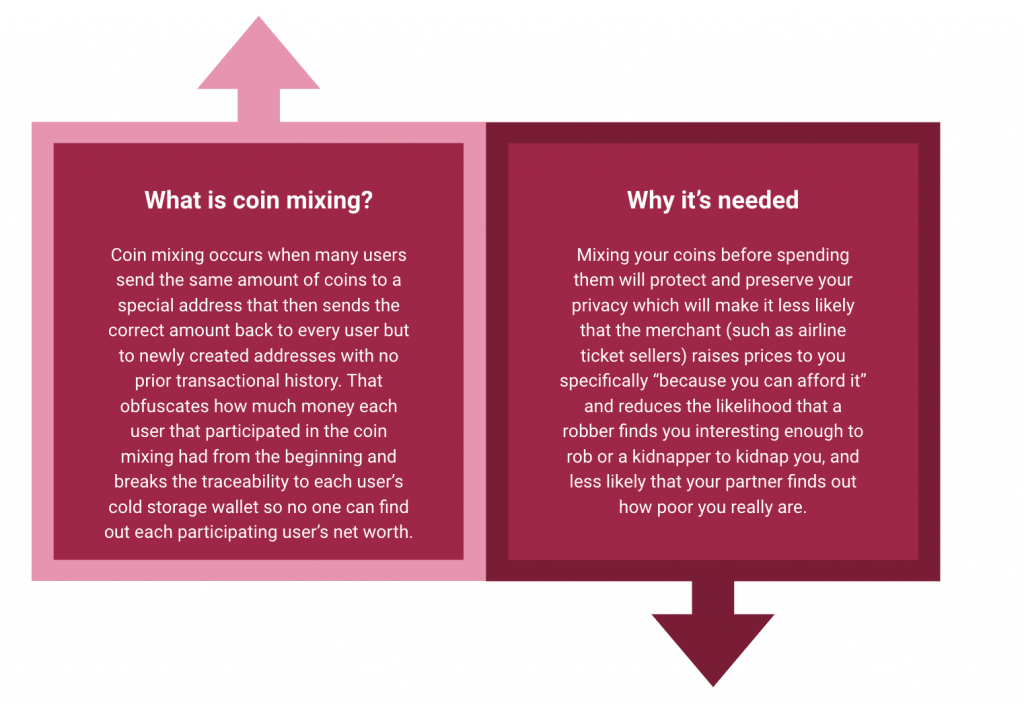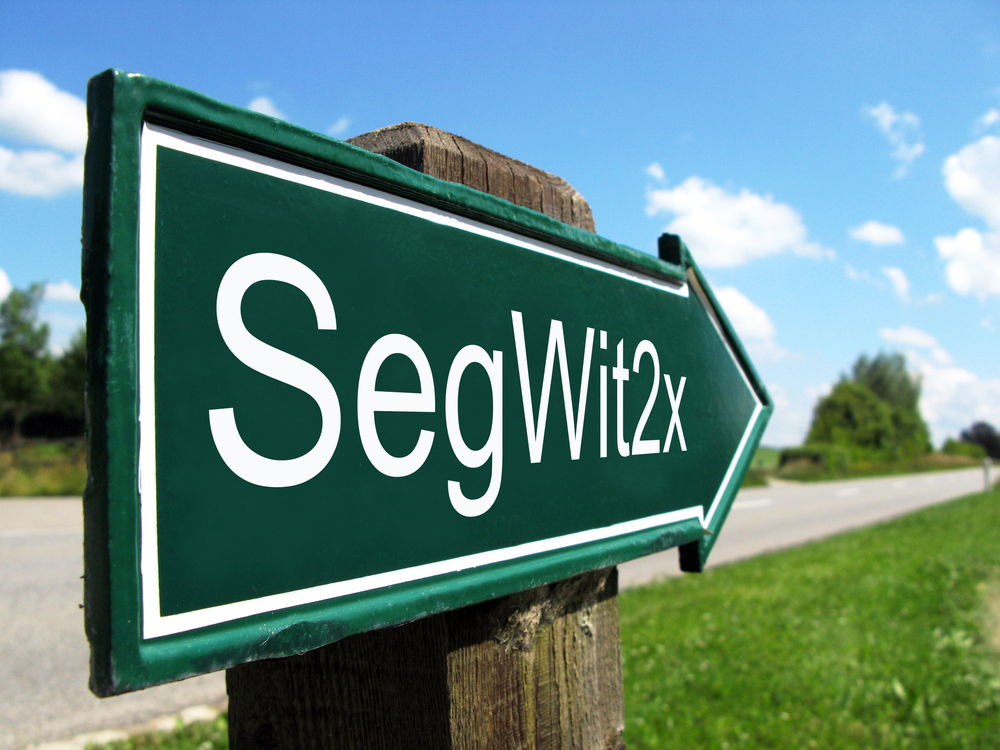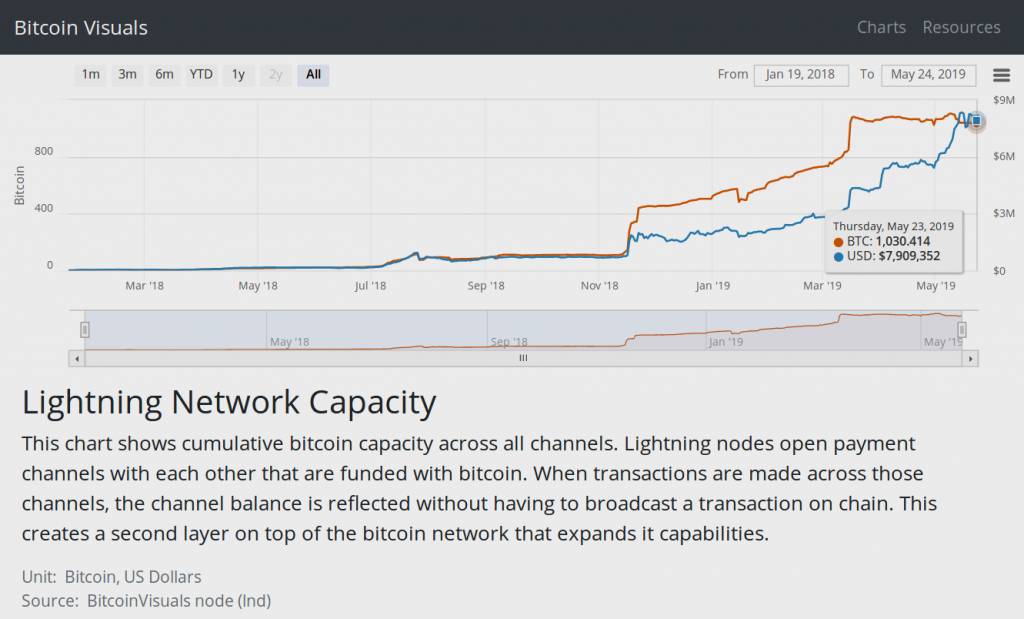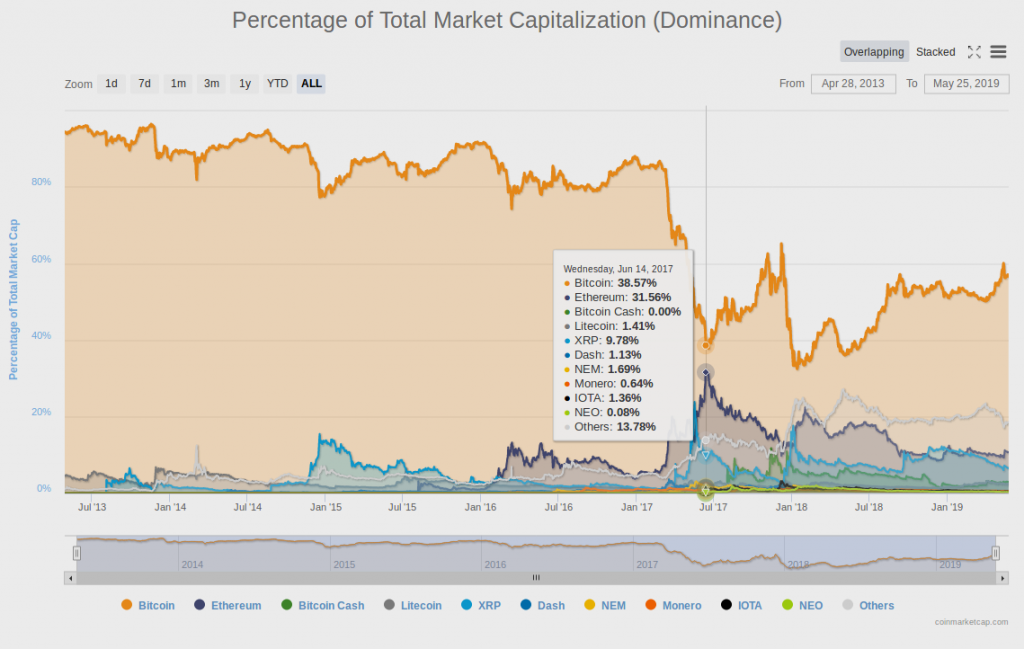
Do you want every person you ever transact with to know how much is in your wallet and your net worth? Of course not. That’s why you need and want to mix your coins to hide where they came from before you use them. The degree of privacy you can expect by default, however, varies significantly depending on whether you are using BCH or BTC.
Also read: Bitcoin Payments Are Being Bulldozed for Political Reasons
How Bitcoin Cash and Bitcoin Core Stack up for Privacy
The Bitcoin (BTC) and Bitcoin Cash (BCH) blockchains are public and possible for everyone to read simply by using any block explorer. So if you have 10 BTC and buy something for 1 BTC then the receiver of the 1 BTC can look at the address that the money came from and see that there used to be 10 BTC there. That would let the merchant know that they can probably raise their prices for you specifically for your next purchase and that you’ll comfortably afford and decide to purchase their merchandise anyway. The merchant employees would also learn that you would be a profitable target for robbery and maybe even kidnapping depending on the amounts and what country you live in or visit. One way to avoid revealing this information to the receiver is to mix your coins first.

Bitcoin Cash (BCH) is better than Bitcoin (BTC) at coin mixing because BCH transaction fees are practically free (less than $0.01 per transaction). The Bitcoin Core scaling roadmap is likely to intentionally cause onchain transaction fees to exceed $30/250 bytes again, just as they were in December 2017. The only reason why BTC transaction fees are currently low is because the cryptocurrency markets entered a bear market shortly after hitting $30 per transaction in 2017. BTC blocks have now started to become full on a regular basis again, and fees have begun to climb.
Criminalizing Coin Mixing
There are rumors that regulators are going to demand that mixed coins will be required to have changed ownership at least six times before they’re no longer considered to be mixed anymore and that fiat-to-crypto exchanges, at the very least, will not be allowed to handle coins that are considered to be mixed because regulators are trying to combat money laundering etc.
The obvious workaround for the trader or general currency user who wishes to preserve their privacy would be to send their already mixed coins six times (to a new address each time that they themselves control) to make it appear as if they were mixed by an owner far enough back in the chain of owners but not “recently”. That way the trader would have preserved their privacy and the exchange would be allowed to consider those coins to no longer be mixed.

The first problem with this is that the intentionally high on-chain transaction fees will make such “legitimizing” prohibitively expensive for BTC users. As a result, most BTC users will not mix their coins at all and only those who are willing to pay extreme amounts in additional transaction fees will mix their coins. That will make such expensively mixed coins look very suspicious compared to coins that have never been mixed.
The second problem is that the only people available to mix their BTC coins with you are people who are desperate enough to pay obscene amounts of fees to have their coins mixed. Your coins would not automatically be mixed with ordinary people who just want privacy. Mixing your coins with such desperate people would be futile, like trying to clean your hands by asking random people to urinate on them. For mixing to work well, ordinary people have to be the majority.
BCH does not have a high fee problem so mixing coins very cheaply and with regular people will most likely become the norm and even the default setting in most BCH wallet apps. This will serve to make mixed BCH coins look normal and not suspicious because “everyone is doing it, it’s practically free to do it and it makes sense to preserve everyone’s privacy in such a cheap and automatic way”.

BTC Mixing Is Costly and Cumbersome
An alternative way for BTC users to obfuscate public knowledge about the total amount in their spending wallets and their net worth could arguably be to use the Lightning Network. But the LN is so cumbersome to use for the common person that it’s unlikely that it will see much user adoption in the near future which means that preserving privacy by using BTC+LN instead of just BTC is unlikely to become the norm.
An example of why the LN should be considered unreasonably cumbersome compared to just using BCH cheaply and directly on-chain “as usual” is that a BTC+LN user first must purchase or otherwise obtain “incoming liquidity” from a liquidity provider such as Bitrefill (for a relatively high monthly fee), before the user can receive money through the LN to their LN wallet app. The user experience for BTC+LN users compared to BTC users is much more cumbersome and unintuitive, so new users should be expected to adopt BCH instead of BTC+LN when BTC on-chain transaction fees become unbearably high for most use cases again in the next bull market or even sooner.
Just think about it:
- People don’t want to use the LN when transaction fees are high because it costs too much to open a channel.
- People don’t want to use the LN when transaction fees are low because then they can just send transactions cheaply and simply directly on-chain.
1+2 together means that most people don’t want to use the LN no matter what the BTC on-chain transaction fees happen to be.
The Blocksize Problem
What does the most recent data say about how real people choose to use BTC as currency? Do people in general accept the scaling roadmap that has been forced through by Bitcoin Core’s new project leader Wladimir van der Laan, despite most of the community loudly preferring the original scaling roadmap as envisaged and designed by the first two Bitcoin Core project leaders Satoshi Nakamoto and Gavin Andresen? The new BTC scaling roadmap forces users to transact using the Segwit and LN technologies by artificially limiting BTC’s base blocksize limit to a tiny 1 MB.
Segwit was designed to give a 75% transaction fee discount to the signature bytes of a transaction, conveniently benefitting LN transactions that use many more signature bytes per transaction than a typical on-chain transaction. Once a bitcoin has been transferred to a Segwit-enabled address, the bitcoin becomes cheaper to send the next time because of this new discount protocol rule. The Segwit technology has been criticized for (among many reasons) being complicated to implement for wallet app developers and a solution to a problem that was created because of the artificially imposed 1 MB base blocksize limit.
It’s one thing to convince the Bitcoin Core project leader, its other project members, the mining pool operators, miners, exchanges and payment processors such as Bitpay to accept the new scaling roadmap. That can be done by investing in a lot of companies, like Barry Silbert (CEO of Digital Currency Group) and a few others did, and then use that influence to make changes to Bitcoin protocol rules and project direction such as its scaling roadmap that really only a few community members want to be changed. Silbert is the person who proposed the Segwit2X “compromise” that was clearly designed to activate only Segwit but not the “2x” part (doubling the base blocksize limit three months after Segwit activated) of the agreement that was also promised. If Barry had honest intentions to activate the 2x part as well then he would’ve obviously designed the agreement to activate both Segwit and 2x at the exact same time so that no one could change their mind during the three-month delay.

It’s much easier to get 58 companies (many of which you’ve invested in) to agree to a clearly deceptively intended Segwit2x agreement than it is to get wallet app development teams to actually implement the complicated Segwit technology. Especially when making ordinary on-chain transactions continues to work, albeit with a higher transaction fee cost due to lacking the new fee discount and due to the base blocksize limit being unreasonably small. There’s also a difference between merely accepting the new protocol rules and actually implementing them as can be seen by looking at how long it takes for exchanges to actually implement Segwit for their incoming and outgoing transactions.
It seems as if Barry Silbert (DCG) forgot to invest in wallet app projects and companies because there were no such signatories (except Blockchain, BTC.com and Coinbase that have wallet apps aside from their main businesses, and Jaxx that only a few BTC people were using at the time) in the so-called New York Agreement.
The Segwit and LN adoption rates should be compared with the median transaction fee paid in USD per transaction during the time period from when transactions were still negligibly low until today. Looking at the median fee is arguably more accurate in this circumstance than looking at the average fee because exchanges and employers usually create one transaction that pays many people at once. The typical person (usually) creates a transaction that pays just one recipient and uses only one or just a few UTXOs per transaction.
What trends can we see? Has Wladimir’s new scaling roadmap worked as intended or have the higher transaction fees had other unintended effects? If we can observe a historical trend then we can try to make a somewhat informed guess about the future trend. So let’s start by looking at the median fees.

The above graph shows that the median fee paid was close to $0 per transaction in January 2017 when blocks were still not full on a regular basis. That’s as expected because the median block was full for the first time ever, starting around six months earlier as can be seen below.

Segwit was activated before the first (arguably) functional LN was released. So let’s look at Segwit adoption and compare it to the first graph with the median fees.

Picking a typical recent day of May 22, 2019 in the above graph shows that BTC users are creating Segwit transactions only in about 38% of the cases. Is that a high or a low adoption rate? That depends on who you ask of course but the more important questions are:
- Has Segwit adoption stagnated?
- Did Segwit adoption rate increase noticeably when the median transaction fee was $34 per transaction in December 2017 (See the first graph)?
So far the answer to the first question is simply “yes”, it has stagnated at around 38% adoption since about April 2018 until today. The Segwit graph shows no movement up or down during December 2017 when BTC median transaction fees were at an all-time high.
Let’s look at LN adoption.
LN was scheduled to be released in June 2016 but was unfortunately “slightly” delayed and released on March 15, 2018 instead. So we can’t see the LN adoption rate during December 2017 because LN simply did not exist yet at that time. But we can see that the amount of BTC that’s being used by the entire LN today is about 1,000 BTC which is only 0.00564% of the current 17.7M supply. That’s not even one percent of one percent of all existing coins.

1,000 BTC (currently $8M) may sound like a lot and it would be for you and me but it’s not much for an entire network that was launched 14 months ago and that’s supposed to handle most BTC transactions according to Wladimir’s new BTC scaling roadmap.
So if Segwit has a very low adoption rate and LN also has a very low adoption rate then what are BTC users doing when transaction fees skyrocket to over $30 for a typical transaction? It seems they leave BTC and start using other currencies that have much lower transaction fees and have a much simpler user experience than BTC+Segwit+LN wallet apps have. Notice how the BTC market cap dominance suddenly decreased by a large percentage for the first time ever in June 2017 just half a month after it was announced that 58 companies had signed Barry’s Segwit2x New York Agreement, making it clear to anyone who still doubted that Bitcoin Core would get a new scaling roadmap that made on-chain transaction fees intentionally and perpetually very high.

Notice how BTC’s dominance suddenly decreased yet again when the less informed users and currency speculators discovered in December 2017 that on-chain transaction fees had become $34 per transaction.
It seems clear now that Bitcoin (BTC) users don’t and won’t accept Wladimir’s new BTC scaling roadmap that tries to force everyone to use Segwit and LN instead of just using direct on-chain transactions. Most BTC users will likely either keep using BTC directly on-chain with high fees or simply stop using BTC and start using one of the many competing cryptocurrencies instead. They simply won’t be willing to regularly pay expensive on-chain transaction fees just to mix their coins to increase their anonymity. That’s prohibitively expensive, even for us first-worlders who earn more than $2 per month.
The Bitcoin Core scaling roadmap seems to have been designed to make it unlikely that regulators, exchanges and tax authorities will allow “suspiciously expensively mixed BTC coins” to be used by the general public. The Bitcoin Cash (BCH) scaling roadmap, on the other hand, is “Bitcoin as usual” which means that mixed BCH coins will likely be considered to be normal because they’ll remain cheap enough to mix so it won’t be “suspicious” for the general public to mix their BCH coins before using them. This difference makes BTC more like a trivially traceable fiat currency, far removed from how its original architects envisioned. Fortunately we have BCH, a fungible cryptocurrency that is simple to use and cheap to mix multiple times over.
Where do you stand on this debate? Share your thoughts on the subject in the comments section below.
This post was written by Tomislav Dugandzic, independent bitcoin cash (BCH) user and currency speculator.
OP-ed disclaimer: This is an Op-ed article. The opinions expressed in this article are the author’s own. Bitcoin.com is not responsible for or liable for any content, accuracy or quality within the Op-ed article. Readers should do their own due diligence before taking any actions related to the content. Bitcoin.com is not responsible, directly or indirectly, for any damage or loss caused or alleged to be caused by or in connection with the use of or reliance on any information in this Op-ed article.
Images courtesy of Shutterstock, Coinmarketcap and Blockchain.com.
Did you know you can verify any unconfirmed Bitcoin transaction with our Bitcoin Block Explorer tool? Simply complete a Bitcoin address search to view it on the blockchain. Plus, visit our Bitcoin Charts to see what’s happening in the industry.
The post BCH vs. BTC: Which Offers Greater Privacy? appeared first on Bitcoin News.
